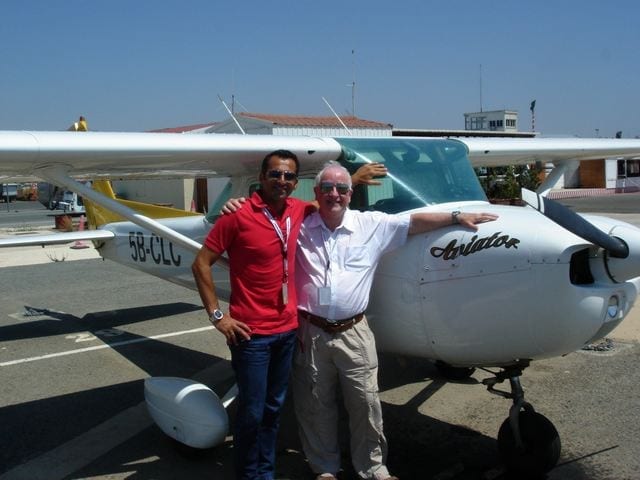In July 2018 I was approaching the end of my flight training. That meant all I had to do was a couple of cross country navigation solo flights on the school’s DA-20 to be ready for the final test. For the US pilots here: Central Europe is a beautiful, mountainous landscape, Slovakia being 60% covered with hills up to mountains between 4000 and 7800 ft. Some pilots from neighboring—rather flatter—countries comment it is impossible to get lost in Slovakia: you have mountain chains, among them squeezed motorways, rail tracks and rivers. There is no way to have the feeling of one town looking like any other from the air.
Needless to say, I was very much enjoying my ride in calm summer air with a magnificent, constantly-changing view below me.
Part of my plan was to perform a touch and go at several airfields along the route. Not because it was required by the training plan but because I liked it, and of course because I wanted to practice. About one hour into my flight, I was approaching LZPT, a grass airfield in a shallow valley among the hilly forests of western central Slovakia. The airport has a nice, although a bit bumpy, grass runway (07-25) with a comfortable 1100 m length—enough for any rookie, including me.
I approached the circuit from the northeast at an altitude of 1500 MSL or 900 ft AGL, heading straight at the center of the runway to observe the wind. Of course, I duly reported on the local frequency I was there and what my intentions were. It seemed there was some wind from northwest, pretty much perpendicular to the runway. There was little movement to be seen at the field (as usual on weekdays) except for one Kitfox-like ultralight parked on the apron near the tower.
So I decided to cross the runway, enter left downwind of 07, and go for my touch and go. Even though I knew the airport and had landed there several times before, I decided to extend the downwind leg to give me time to do it properly—right on first attempt.
So when I turned on final I was about three miles from the threshold. All went well, I reported final on 07, and was getting ready to perform a smooth touch down right past the threshold.
Then, about one minute before touch down, I heard somebody saying something like, “LZPT taking off runway 25.” I was not sure I heard right. I mean, I just reported my final about a minute ago. Surely anybody on the frequency, let alone a pilot sitting in his aircraft about to take off, must have heard me?
I played this movie in my head, thinking, “you are a rookie, you don’t know what you are doing, you’re so stressed you cannot even comprehend radio communication, you must have misunderstood, anybody around you knows more than you—YOU ARE NOT EVEN A PILOT YET.” So I continued my approach but, luckily, kept a very sharp eye.
Then, to my great awe, I spotted that previously parked Kitfox looking very much like it was speeding down runway 25 right towards me. Clearly, I must have understood him—he was about to take off on the runway I was abut to land on! Not much more thinking was needed, so I put in full power, retracted my flaps and peeled right, gaining altitude. And, I managed to report, “Go around due to traffic ahead” in a surprisingly calm voice.
As I proceeded to and reported left downwind for runway 25, nobody responded. The airfield became perfectly deserted after the Kitfox departed. I managed to finish the circuit, perform a bit of a shaky full stop landing, stepped out of the airplane and stretched a bit. Fifteen minutes later, I was in the air again, continuing on my planned route towards Bratislava International (LZIB), where I landed 45 minutes later.
As I was reflecting on the events, I came to some rather obvious conclusions:
- If you sense danger then speak out. The radio is there to be used.
- Your gut gives you a good direction—it is OK to follow it and double check by the brain—not to try to reason your intuition away.
- It does not matter much who was guilty after the accident; what matters more is who could have prevented it and did not.
- This one I heard from my instructor, perhaps in the second lesson: “In the air we don’t think, we act.” Good advice if you follow it.
As I write this I am a happy 100 hour PPLA time builder. I may be a bit over-communicative on the radio but have not had a close call since that day in July 2018.
- A severe, multi-day case of “get-there-itis” - February 7, 2022
- Read the NOTAM—my conflict with Air Force One - February 9, 2021
- That radio is there for communication: a close call - June 2, 2020













Unfortunately this is probably the first in many of your “I encountered an idiot in the pattern” experiences. You are right to be spring-loaded to abort an approach and get off the extended centerline at the first hint of a conflict like this. I’m hypervigilant for opposite-direction conflicts when there is calm wind, or a light wind and a long runway, particularly where the FBO is at the upwind end of the field (who wants to taxi all the way to the correct runway?).
While inadequate communication occurs under all circumstances, consider the instrument pilot who switches off of CTAF to pick up a clearance, then is given an immediate release. That’s not an excuse for not monitoring CTAF, but one of many circumstances where someone who should be listening simply isn’t, gets in to a hurry to take off, and creates a conflict. Expect it to happen, and be spring-loaded to maneuver to avoid.
LOL. This was great. It reminded me of the time in Roanoke, Virginia many years ago when we watched some kid in a Cessna 172 doing touch-and-goes at night on runway 23 without talking to the tower at all. We arrived from Dulles Airport in our Metroliner while this was going on, and were duly cautioned by the tower man about this wacky pilot who had flown in from some unknown airport and entered the pattern ( A RIGHT pattern, not left, as required…) to begin a series of touch and goes (IN PITCH BLACK NIGHT) without ever talking to anyone. We avoided him, of course, and landed our airplane, and then stood out by the wing for half an hour watching all the excitement (other airplanes were arriving and departing, too) before he finally decided he’d had enough takeoff and landing practice. He then exited the runway, came to a complete stop, and then proceeded to call ground control for taxi instructions!! I think they boiled him in oil.
Two minutes on final? Three miles? Keep a tight pattern and you can see better what’s going on with ground traffic. It’s easier for them to see you as well.
Keeping the pattern tight also makes it easier to fly consistent approaches. The sight picture from the cockpit of your intended landing spot between the turn to base through very short final is what you want ingrained in your mind. Extending the downwind won’t help.
There is nothing wrong with doing a long final, it’s called a stabilized approach. if the pilot departing made an initial departure call before his takeoff call this wouldn’t have happened.
The uncontrolled airport is the most dangerous airport around. Usually it’s the rookies that make all the proper radio calls, it’s the experienced, cocky pilots you have to watch for.
Pavol::
Good story. Thanks.
Your list of four lessons reviewed and learned is great value added.
Best to you. I’ve wondered about flying in Europe. My experience as PIC is all in the North American airspace (Canada, US, Mexico).
FWIW, I’ve noticed the same problem Mike pointed out: “…it’s the experienced, cocky pilots you have to watch for…” I guess it’s a universal rule that age and experience can lull us into foolish behaviors.
Thanks again for a great story,
John
Your radio call might not been heard anyway ….probably wrong frequency usually the problem. At our local airport recently the ground vehicle doing airport checks nearly got landed on. New radio in aircraft the pilot had not taken the time to familiarise himself with. Hence wrong frequency.
Frequency was correct as I heard his call when he was about to take off. I should have repeated my call on final and he would be able to abort. I guess he just jumped into the cockpit, made his call and took off. My active radio communication could have prevented the situation. Glad I could learn from this.
Recently viewed and participated in a discussion about runway selection. We must keep in mind there are several potential factors in selecting a runway to depart or land on. Of course wind direction is one, but length of runway, destination direction, shortened taxiing, obstructions, and more. We can’t always expect aircraft are using a runway just because it is favorable to the wind. This past year a collision on the ground between a corporate jet and a small Cessna cost 2 lives at a non-towered airport. Seems the Cessna was departing on runway like 15 while the corporate was landing on 18 of the crossing runways. Just after liftoff the Cessna collided with the vertical stabilizer of the jet. I haven’t read any NTSB reports of the accident, but suspect communication was disrupted Or missing and the Cessna didn’t look hard left to see the approaching jet. For whatever reason the jet didn’t see or maybe didn’t receive any departure communication from the Cessna. My point is that anytime there are crossing runways, regardless of the wind direction, we must be vigilant to make certain visually that we aren’t on a collision course with another aircraft.
Talking is important, also be sure YOU are on the good frequency. Sometimes this is the reason why that airfield seems quiet…
Had a similar experience with a NORDO ultralight taking off opposite direction while I was on short final. Just like you described, it took me a few seconds to get over the disbelief and react, and I’ve got almost 20 years of flying experience. Nice article.
Reminds me of the time my wife and I were returning home from a trip. I made my intentions to land on 31 and position calls and soon after, another aircraft made known his intentions t o land on 13 and his position call. I kept making calls followed by his position calls. I was on less than a 1/4 mile final when out of the corner of my eye, I saw another aircraft cross the threshold to runway 4. I called the aircraft still on approach to 13 telling him to abort and why. We both circled and landed on 13. The plane who landed on 4 never made any calls and was put away in hangar ?? by the time we got parked.